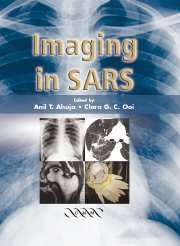Book contents
- Frontmatter
- Contents
- Contributors
- Preface
- 1 The Epidemiology of Severe Acute Respiratory Syndrome: A Global Perspective
- 2 The Role of Emergency Medicine in Screening SARS Patients
- 3 Severe Acute Respiratory Syndrome Outbreak in a University Hospital in Hong Kong
- 4 Imaging of Pneumonias
- 5 The Role of Chest Radiographs in the Diagnosis of SARS
- 6 Chest Radiography: Clinical Correlation and Its Role in the Management of Severe Acute Respiratory Syndrome
- 7 The Role of High-Resolution Computed Tomography in Diagnosis of SARS
- 8 The Role of Imaging in the Follow-up of SARS
- 9 Treatment of Severe Acute Respiratory Syndrome
- 10 SARS in the Intensive Care Unit
- 11 Imaging of Pneumonia in Children
- 12 Imaging and Clinical Management of Paediatric SARS
- 13 Imaging of SARS in North America
- 14 Radiographers' Perspective in the Outbreak of SARS
- 15 Implementation of Measures to Prevent the Spread of SARS in a Radiology Department
- 16 Aftermath of SARS
- 17 Update on Severe Acute Respiratory Syndrome
- Index
1 - The Epidemiology of Severe Acute Respiratory Syndrome: A Global Perspective
Published online by Cambridge University Press: 27 October 2009
- Frontmatter
- Contents
- Contributors
- Preface
- 1 The Epidemiology of Severe Acute Respiratory Syndrome: A Global Perspective
- 2 The Role of Emergency Medicine in Screening SARS Patients
- 3 Severe Acute Respiratory Syndrome Outbreak in a University Hospital in Hong Kong
- 4 Imaging of Pneumonias
- 5 The Role of Chest Radiographs in the Diagnosis of SARS
- 6 Chest Radiography: Clinical Correlation and Its Role in the Management of Severe Acute Respiratory Syndrome
- 7 The Role of High-Resolution Computed Tomography in Diagnosis of SARS
- 8 The Role of Imaging in the Follow-up of SARS
- 9 Treatment of Severe Acute Respiratory Syndrome
- 10 SARS in the Intensive Care Unit
- 11 Imaging of Pneumonia in Children
- 12 Imaging and Clinical Management of Paediatric SARS
- 13 Imaging of SARS in North America
- 14 Radiographers' Perspective in the Outbreak of SARS
- 15 Implementation of Measures to Prevent the Spread of SARS in a Radiology Department
- 16 Aftermath of SARS
- 17 Update on Severe Acute Respiratory Syndrome
- Index
Summary
Introduction
Severe acute respiratory syndrome (SARS) is a newly emerged disease caused by a previously unknown coronavirus. It joins a long list of emerging infections. However, unlike other contenders such as avian influenza, Nipah virus, Hendra virus or hantaviruses it has established the capacity for efficient human-to-human transmission and thus poses a major threat to international public health. For this reason, the World Health Organisation (WHO) has described SARS as the first serious and readily transmissible disease to emerge in the 21st century.
The first known cases of SARS occurred in Guangdong Province in southern China in late November 2002. The first official report of an outbreak of atypical pneumonia in the province on 11 February 2003 indicated that the disease had affected 305 persons and caused five deaths, and that around 30% of cases had occurred in health care workers. On 21 February 2003, a medical doctor infected with SARS travelled from Guangzhou, the provincial capital, and stayed one night at a hotel in Hong Kong. He infected at least 16 other guests and visitors in the hotel. Within days, the disease began spreading around the world along international air travel routes as hotel contacts seeded hospital outbreaks in Hong Kong, Vietnam, Singapore and Canada (Figure 1.1).
- Type
- Chapter
- Information
- Imaging in SARS , pp. 1 - 16Publisher: Cambridge University PressPrint publication year: 2004

